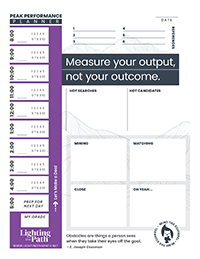
Building a high-trust leadership culture starts with understanding, not goals. If you want to build a high-performing team, you don’t start with goals. You start with understanding—and that’s exactly how to practice intentional leadership. I talk more about growth mindset and leadership clarity in my post on How Better Beats Best.
That was one of the powerful threads running through my recent conversation with leadership advisor Shannon Nutter. Shannon has led strategy, global operations, and product development at one of the largest investment firms in the world, and now she consults with boards and advises leaders on how to build the right conditions for people—and performance—to thrive.
Building Leadership Culture Through Understanding
Early in our conversation, the theme of digging deeper came up. Not as a slogan, but as a leadership imperative. In Shannon’s world, great leadership doesn’t begin with answers. It begins with curiosity.
“Great strategy, great technology, great culture,” she said, “all start with understanding the real needs—spoken and unspoken.”
She’s right. In a fast-moving world, we often default to solving what’s most visible. We respond to what’s said out loud, not what’s left unsaid. We race to fix processes instead of asking if we’re solving the right problems. But when we slow down and ask better questions—when we dig deeper—we shift from reactivity to intentionality.
And that shift is where everything changes.
The Culture You Feel: Practicing Intentional Leadership Daily
A key step in how to practice intentional leadership is modeling trust, especially in how you respond to challenges.
Shannon and I moved quickly from digging deeper to culture, because the two are deeply linked. Culture isn’t created through mission statements or perks—it’s created through consistent, intentional leadership.
“Culture,” she said, “isn’t just how people get work done. It’s how the environment makes them feel while they’re doing it.”
Let that sink in. Culture isn’t about bean bags or baristas—it’s about the emotional experience of being part of the team. It’s whether people feel clarity or confusion. Alignment or friction. Encouragement or fear.
And most of all, it’s whether people feel safe.
Shannon and I both agreed that culture is one of the most overused and misunderstood words in business. Many leaders talk about culture as if it’s a byproduct of good intentions or company heritage. But culture isn’t what you hope people feel—it’s what they actually experience.
You don’t define your culture by putting values on a poster. You define it by how you handle a tough meeting, how you respond to failure, and how you follow through on what you promised. The leaders I admire don’t talk about culture—they model it.
As Shannon put it, “You know the culture’s healthy when someone in a meeting says, ‘I’m struggling,’ and the team leans in, not away.”
That kind of psychological safety doesn’t happen by accident. It’s cultivated. And the soil it grows in is called trust.
You can experience these principles more deeply through our Lighting the Path Leadership Mastermind Group, where intentional leadership is practiced, not just discussed.
Compliance Is Easy. Commitment Is Earned.
The real job of leadership isn’t to control outcomes. It’s to earn commitment.
Too often, leaders aim for compliance. They want people to follow directions, hit metrics, stay on task. Compliance lives in the mind—it’s rational and limited. But commitment? Commitment lives in the heart.
It’s emotional. It’s voluntary. And it can’t be faked.
“You’re not just trying to capture someone’s mind,” I told Shannon. “You’re trying to capture their heart.” She nodded in agreement, adding that the best teams she’s led were the ones where support, trust, and care were actively cultivated—by the leader and among teammates.
This distinction matters, because most organizations measure success through lagging indicators. They look at sales numbers, retention rates, project completion, revenue per headcount—data that tells you what already happened.
But lagging indicators are like looking in the rearview mirror. They’re outcomes of something deeper.
Want to know what’s coming next in your business? Don’t just watch the numbers. Watch the culture.
How people feel today will shape how they perform tomorrow. Whether they speak up in a meeting, challenge a flawed decision, go the extra mile, or stay with the company—all of it begins with how safe, seen, and supported they feel in the present.
Culture is your leading indicator. Performance is your lagging one.
So if you want to change the results, you’ve got to change the experience.
The Invitation to Go Deeper: How to Practice Intentional Leadership
Leadership isn’t a title—it’s a practice. And the leaders who make the biggest difference are the ones who are willing to pause. To ask better questions. To hold space for silence. To sit with a conversation a little longer, because something important might be beneath the surface.
This isn’t always efficient. But it’s what builds commitment.
It’s easy to run a report. It’s harder to ask someone, “How are you really doing?” It’s easy to move on when someone says, “I’m fine.” It’s harder to circle back later and say, “You didn’t seem like yourself earlier. Want to talk?”
But this is where the real work of leadership lives.
So here’s a challenge for all of us: Before you try to fix something, understand it. Before you push someone, know them. Before you try to manage culture, model it.
If you’re ready to go deeper, start with these questions:
- Am I reacting to symptoms, or addressing root issues?
- When was the last time I asked, “What am I not seeing?”
- Do I create space for open-ended exploration in my meetings?
- How well do I understand the unspoken needs of my team?
These aren’t just reflection points—they’re access points. Because when people feel understood, they engage. When they feel safe, they contribute. And when they feel led—not managed—they commit.
That’s the real work of leadership. It’s not about surface-level control. It’s about building trust, creating clarity, and having the courage to go beneath the obvious.
Dig deeper. Build culture. Earn commitment.
It’s not easy. But it’s everything.



